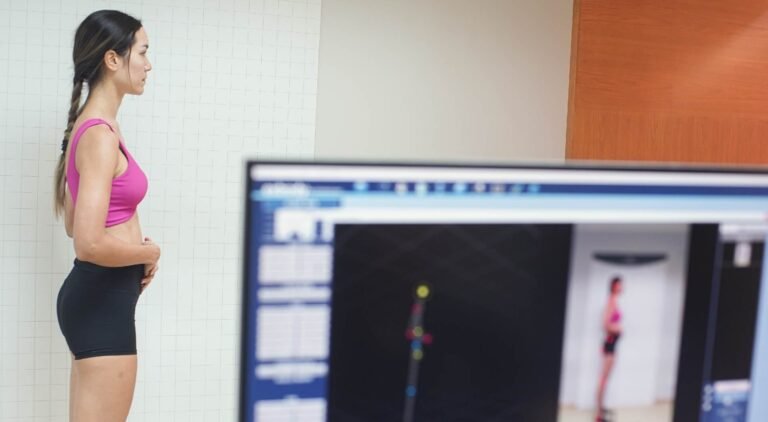The lumbar spine, or lower back, is key to our body’s structure. This article dives into its function, anatomy, and common problems. It covers the bones, discs, nerves, and muscles that make up this area. Understanding these parts helps us see how important the lower back is for our health and movement.
It looks at issues like herniated discs and spinal stenosis. It also talks about degenerative disc disease and facet joint syndrome. By learning about these conditions, we can better handle them. This leads to a healthier lower back and a better life.
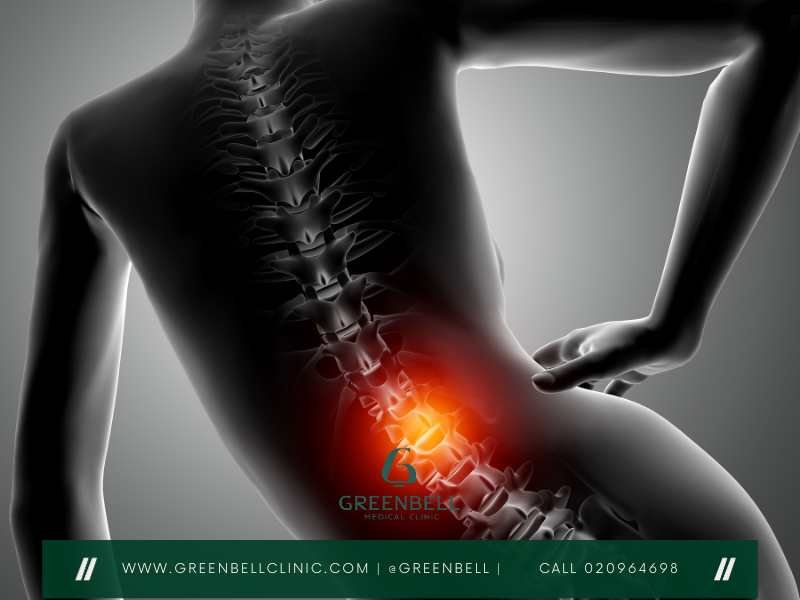
Key Takeaways
- The lumbar spine is a crucial component of the human body, responsible for supporting the upper body, facilitating movement, and protecting the spinal cord.
- Detailed understanding of the lumbar spine’s anatomy, including vertebral bodies, discs, nerves, and supporting muscles, is essential for identifying and addressing common disorders.
- Prevalent lumbar spine conditions, such as herniated discs, spinal stenosis, degenerative disc disease, and facet joint syndrome, can cause significant lower back pain and impairment.
- Recognizing the symptoms, causes, and treatment options for these disorders can help individuals take proactive steps to maintain a healthy and functional lower back.
- Maintaining core strength, proper posture, and a balanced exercise routine can contribute to the overall health and well-being of the lumbar spine.
Understanding the Lumbar Spine
The lumbar spine, or lower back, is key to supporting our upper body and helping us move. It transfers weight and forces from our torso to our hips and legs. This lets us stand, bend, twist, and do many activities.
Importance of the Lower Back
The lumbar spine is vital for keeping good posture, balance, and flexibility. It has the largest spinal nerve roots, including the L1 spinal nerve, L5 spinal nerve, and L2, L3, and L4 spinal nerves. These nerves help our lower legs move and feel sensations.
Defining the Lumbar Region
The lumbar spine has five vertebrae, labeled L1 through L5. It’s between the thoracic (upper back) and sacral (pelvic) regions. Its unique lordotic curve helps distribute weight and absorb shock. This improves the lumbar spine function anatomy disorders.
| Spinal Region | Vertebral Levels | Key Functions |
|---|---|---|
| Lumbar Spine | L1 – L5 |
|
Lumbar Spine Anatomy
The lumbar spine is a complex and fascinating structure. It has distinct parts that work together to support the body’s movements and protect the spinal cord. Let’s explore the details of the lumbar spine’s anatomy, focusing on the vertebral bodies, discs, and the important spinal nerves.
Vertebral Bodies and Discs
The lumbar spine has five vertebral bodies, labeled L1 to L5. These solid bones provide the foundation for the lower back. They support the weight of the upper body and allow for movement.
Between each pair of vertebral bodies are the intervertebral discs. These discs act as shock-absorbing cushions. They allow for smooth and flexible movements.
The discs have a tough outer layer called the annulus fibrosus and a soft inner core called the nucleus pulposus. This structure lets the discs compress and expand. This enables the spine to bend, twist, and flex without harming the spinal cord and spinal nerves that pass through the intervertebral foramina.
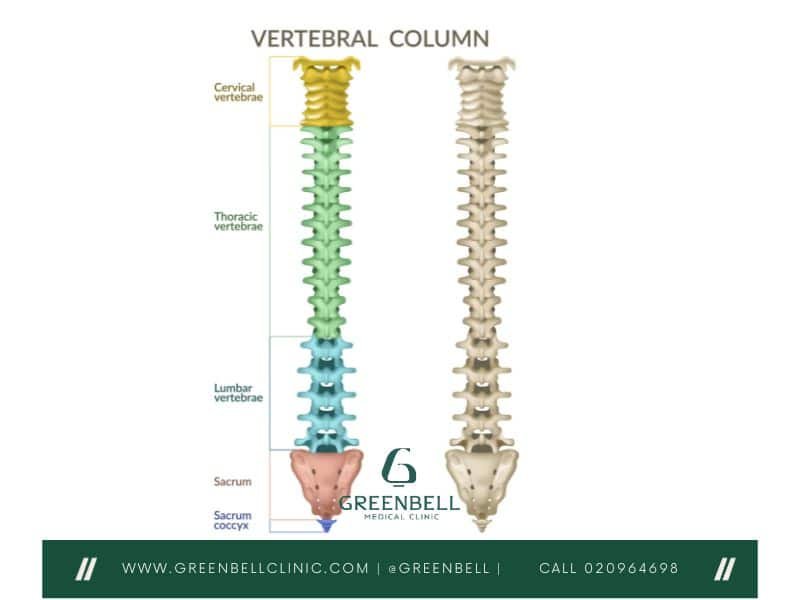
Spinal Nerves and Foramen
The intervertebral foramina are openings on the sides of the vertebral bodies. They allow the spinal nerves to pass through. These nerves innervate the body’s muscles, organs, and tissues. They play a key role in sensation, movement, and autonomic function.
Keeping the vertebral discs, spinal nerves, and intervertebral foramina healthy is crucial. Disruptions or abnormalities in these structures can lead to serious conditions. These include herniated discs, spinal stenosis, and radiculopathy.
| Anatomical Structure | Function |
|---|---|
| Vertebral Bodies | Provide structural support and facilitate movement in the lumbar spine |
| Intervertebral Discs | Act as shock-absorbing cushions between the vertebral bodies, allowing for flexible movements |
| Spinal Nerves | Originate from the spinal cord and innervate the various muscles, organs, and tissues throughout the body |
| Intervertebral Foramina | Openings through which the spinal nerves pass, connecting the spinal cord to the rest of the body |
Understanding the lumbar spine’s anatomy is key to a healthy lower back. By knowing the structures and their roles, we can appreciate the importance of this region. We can also recognize potential issues that may arise.
Facet Joints and Ligaments
The lumbar spine, the lower part of the backbone, is complex. It’s supported by facet joints and ligaments. These parts are key for stability, flexibility, and function in the lower back.
The facet joints are small, gliding joints between each vertebra. They let the spine move smoothly, allowing us to bend, twist, and extend. Keeping these joints aligned is crucial for the spine’s health and avoiding problems like facet joint syndrome.
Around the vertebrae and facet joints, there are ligaments that stabilize the lumbar spine. The ligaments of the lumbar spine include the posterior longitudinal ligament, anterior longitudinal ligament, and ligamentum flavum. These tissues are strong yet flexible, working together to keep the spine stable.
| Facet Joints | Ligaments of the Lumbar Spine |
|---|---|
|
|
Knowing how facet joints and ligaments of the lumbar spine work is key to a healthy lower back. Taking care of these parts can prevent pain and ensure the spine moves smoothly without pain.
Muscles Supporting the Lumbar Spine
The lumbar spine, at the lower back, is supported by many muscles. These muscles help keep the back straight, stable, and moving well.
Core Muscle Groups
The core muscles include the abs, obliques, and transverse abdominis. They are key in supporting the lumbar spine. These muscles add strength and stability, protecting the spine and improving back health. Engaging the core helps improve core strength and posture.
Back Extensor Muscles
The back extensor muscles extend and rotate the spine. They include the erector spinae, multifidus, and quadratus lumborum. These back muscles keep the spine aligned and support the lower back. Strengthening them can reduce lower back pain.
| Core Muscle Groups | Back Extensor Muscles |
|---|---|
|
|
“Strengthening the core and back extensor muscles is essential for maintaining a healthy and stable lumbar spine.”
Knowing the muscles that support the lumbar spine helps in creating better exercise routines. It leads to stronger core strength and back muscles. This improves posture and lowers the risk of lower back pain.
Lumbar Spine Function Anatomy Disorders
The lumbar spine is key in supporting the upper body and enabling movement. It also protects the spinal cord. Its anatomy is complex, working together to ensure smooth function.
The vertebral bodies and discs in the lumbar area provide a stable base. They allow for weight transfer and support during activities. The spinal nerves passing through the foramen send signals for movement and sensation in the lower body.
The facet joints and ligaments around the vertebrae limit excessive movement. This prevents injury and keeps the spine stable. The muscles, like the core and back extensors, help maintain posture and support movement.
Disruptions in the lumbar spine’s anatomy can cause disorders like herniated discs and spinal stenosis. Knowing how the lumbar spine works is essential for treating these conditions.
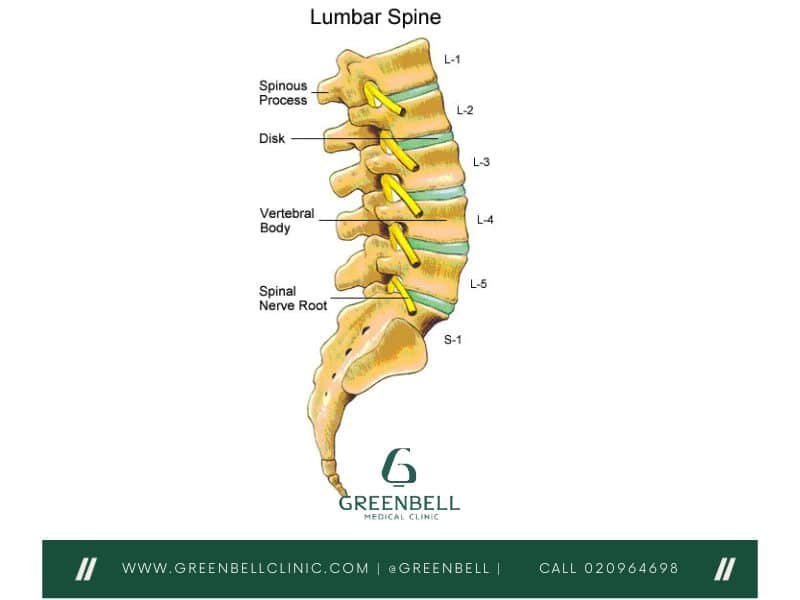
Common Lumbar Spine Disorders
The lower back, or lumbar spine, can get hurt in many ways. This can make it hard to do everyday things. Herniated discs and sciatica, along with spinal stenosis and spondylolisthesis, are common problems.
Herniated Discs and Sciatica
A herniated disc happens when the soft part of a disc bulges out. This can press on nerves and cause pain. Sciatica is when this pain spreads down the leg.
Many things can cause herniated discs, like getting older or injuries. Symptoms include back pain, leg pain, and trouble walking.
Spinal Stenosis and Spondylolisthesis
Spinal stenosis means the spinal canal gets smaller. This can hurt nerves and cause pain. Spondylolisthesis is when a vertebra slips out of place, also causing pain.
Symptoms include back pain, trouble walking, and numbness in the legs. Treatment can be physical therapy or surgery, depending on the case.
Knowing about these back problems is key to getting help. Early treatment can help you feel better and live better.
Degenerative Disc Disease
Degenerative disc disease is a common issue in the lumbar spine. It often causes lower back pain and other problems. This condition happens when the discs between the vertebrae wear down over time.
Causes and Risk Factors
Many things can cause degenerative disc disease. Aging is a big one. So is injury or trauma to the spine. Certain health conditions can also play a role.
As we age, our discs lose their shock-absorbing ability. This makes them more prone to damage. Risk factors include:
- Aging
- Obesity
- Sedentary lifestyle
- Repetitive heavy lifting or twisting
- Smoking
- Genetic predisposition
Symptoms and Treatment Options
People with this disease may feel lower back pain, stiffness, numbness, and muscle weakness. The severity of these symptoms can vary.
Treatment often starts with non-surgical methods. This includes physical therapy, medication, and changes in lifestyle. In severe cases, surgery might be needed. The goal is to ease symptoms and slow the disease’s progress.
| Symptom | Treatment Option |
|---|---|
| Lower back pain | Pain medication, heat/ice therapy, physical therapy |
| Numbness and tingling | Nerve medication, epidural injections, spinal decompression |
| Muscle weakness | Strengthening exercises, core stabilization program |
| Severe, persistent symptoms | Spinal fusion, disc replacement surgery |
Managing degenerative disc disease requires a detailed plan. It’s about addressing the root causes and improving life quality. By understanding the condition and exploring treatment options, people can manage their symptoms and live an active life.
Facet Joint Syndrome
Facet joint syndrome is a common cause of chronic lower back pain. It affects the small joints between the vertebrae, called facet joints. These joints help the spine move smoothly and without pain.
As we age, the cartilage in these joints wears down. This can cause inflammation, irritation, and pain. Injuries can also damage the facet joints, leading to this condition.
- Symptoms of facet joint syndrome include:
- Localized lower back pain that may radiate to the buttocks or legs
- Stiffness and decreased range of motion in the lower back
- Tenderness or pain when pressing on the affected facet joints
- Difficulty standing or walking for extended periods
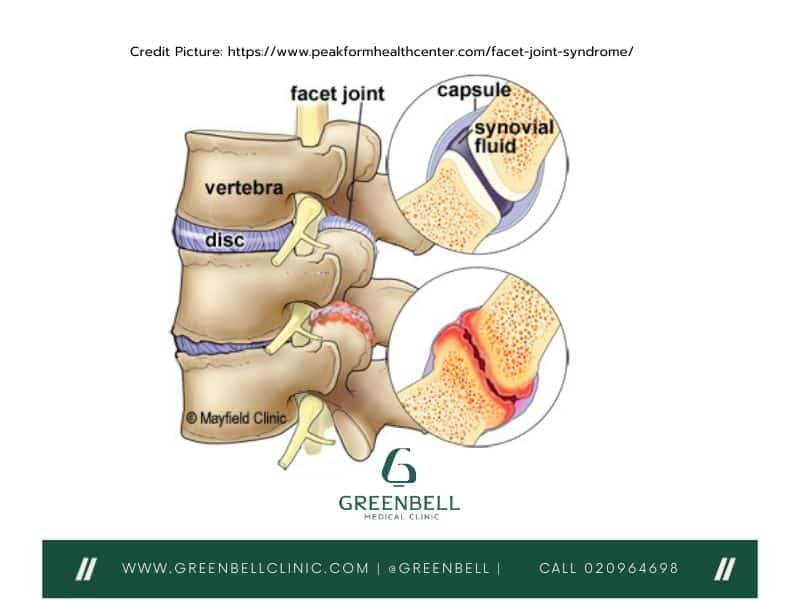
To diagnose facet joint syndrome, doctors do a physical exam, review your medical history, and use imaging tests like X-rays or MRI scans. Sometimes, a facet joint injection is used to confirm the pain source and guide treatment.
The first steps in treating facet joint syndrome are usually non-surgical. This includes:
- Over-the-counter pain medications to reduce inflammation and alleviate discomfort
- Physical therapy exercises to improve flexibility, strength, and range of motion
- Heat or cold therapy to manage pain and swelling
- Spinal injections, such as facet joint injections or medial branch blocks, to provide temporary relief
In severe or persistent cases, surgery might be needed. This could include radiofrequency ablation or facet joint denervation. These surgeries aim to reduce pain by blocking pain signals from the facet joints.
If you have ongoing lower back pain or think you might have facet joint syndrome, see a healthcare professional. They can diagnose and create a treatment plan just for you. Early treatment and a team approach can help manage this condition and improve your life quality.
Conclusion
This article has given a detailed look at the lumbar spine. It covers its function, anatomy, and common problems. Knowing about the lower back helps people take care of it and get help when needed.
In Bangkok, the Greenbell Physiotherapy Clinic offers top-notch care. They create custom treatment plans for lumbar spine issues. Their team uses proven methods to help with problems like herniated discs and spinal stenosis.
Keeping the lumbar spine healthy is key for feeling good and living well. Learning about the lower back helps people make smart health choices. It also encourages them to get the right help to keep their spine strong and flexible.



